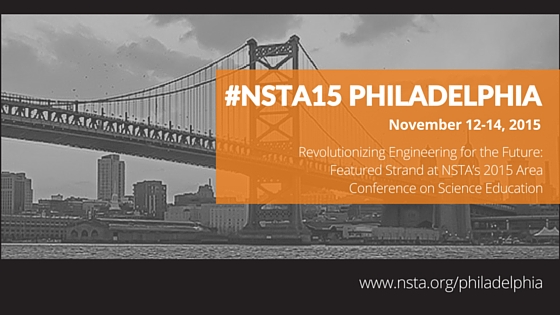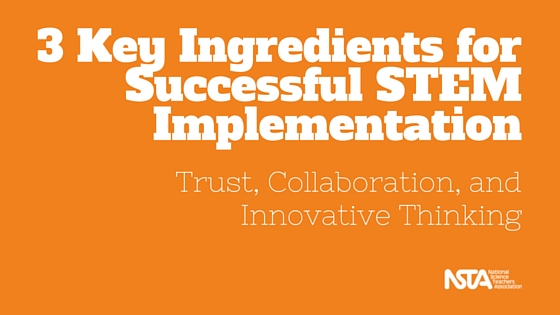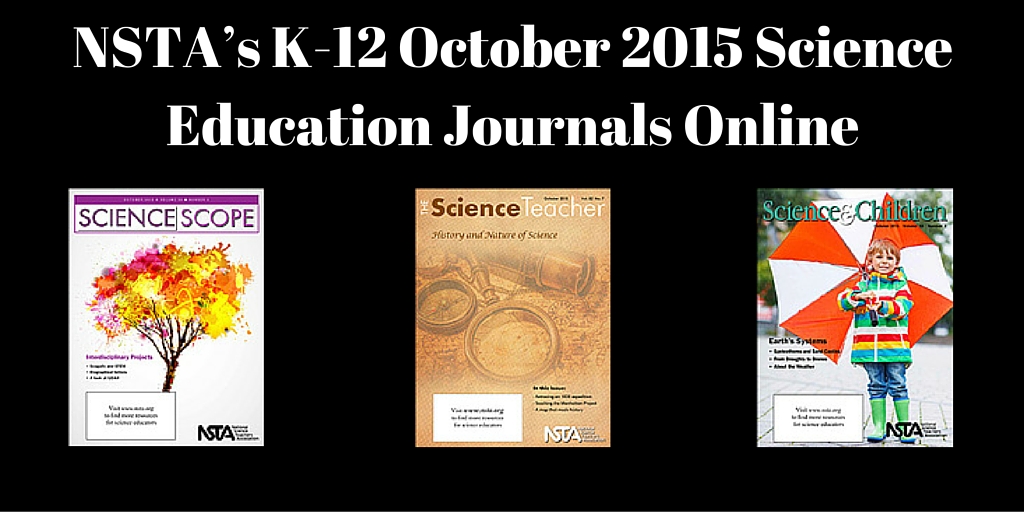Teaching Climate Change With Stories of Success
By Guest Blogger
Posted on 2015-10-07
Science teachers often find teaching about climate change challenging; when they discuss the dire consequences of rising CO2, students have a propensity to shut down. The common belief has been that if people understood climate change science, they would want to do something about it. But years of speaking to students about environmental issues made it clear to me that messages of gloom and doom elicit reactions of fear, demoralization, and hopelessness. However, when I shared inspiring stories about youth actions to, for example, preserve land or clean up rivers, it allowed young people to hear the bad news because they understood they had the power to change things. Positive, solutions-oriented stories motivated students to try to make a difference. And social science research confirms the importance of a positive approach.
“Motivated avoidance” is the tendency of people to avoid learning about troubling issues and seemingly intractable problems. The 2012 study, “On the Perpetuation of Ignorance: System Dependence, System Justification, and the Motivated Avoidance of Sociopolitical Information,” published in the Journal of Personality and Social Psychology, showed people are motivated to avoid learning more about problems that they think they can’t do anything about. People become blind to facts when confronted with disturbing scientific information. A study by the Yale Project on Climate Change (2014) corroborated this, showing that alarmist images were the least likely to motivate viewers to action.
These studies make it clear that social science must be considered when teaching about climate change; they show that environmental education and information itself does not motivate people to act. In fact, depressing environmental information delivered without the counterbalance of solutions can be counterproductive, turning some people into climate “ostriches” who bury their heads in the sand. The appeal of “ostriches” and “deniers” is that they say what people wish to be true and psychologically wish to hear—unless an alternative scenario espousing action is presented.
Realizing the power of success stories to provide inspiration and role models for young people, photojournalist Gary Braasch and I founded the nonprofit Young Voices on Climate Change. Our Young Voices for the Planet (YVFP) films showcase youth reducing C02 emissions through many creative win-win scenarios, engaging local governments, businesses, and school administrators and helping their peers develop confidence in themselves as agents of change in the world. We champion and publicize these inspirational, authentic, and positive youth-led models of social action, filling an important niche in climate education.
In teaching about climate change, it is essential to begin teaching about troubling issues with hope and inspiration. Youth success stories need to precede the teaching of climate science and other wrenching environmental issues. Stories of youth “taking the reins” provides a wonderful engagement point for teachers wanting to help students who are interested in becoming agents of change and helping to protect the planet. These relevant stories also act as a lens through which to teach climate science.
Some of the youth documented in the YVFP films include 12-year-old Alec, who erects Sea Level Awareness posts along coastal California, speaks to Congress, and advocates for putting a price on carbon; Team Marine, who helped pass bans on plastic bags; 11-year-old Olivia, who raised $200,000 to clean oiled birds after the BP spill and advocates for renewable energy; and high school students who created a healthy school lunch through their school garden and local community partners.
The most recent YVFP film, Save Tomorrow, documents the motivational power of the other YVFP films. After watching the YVFP films, nine-year old Alice founded a “Save Tomorrow” club that helped solarize her school and town and save a forest. Once they realized they, too, had power, Save Tomorrow has become unstoppable. As Olivia states, “If they can do that, then so can I.”
Youth action can act as an antidote to the fear surrounding climate change. By making the teaching of climate change hopeful and relevant, students can absorb the science that is essential that they learn, as they will inherit a warmer world and will bear the brunt of climate disruption. Studies show the importance of beginning any teaching about the science of climate change with stories of hope, empowerment, and solutions. Your students are no different from the youth in the YVFP films and can become exemplars of hope and empowerment, as well as how we all can, and must, make a difference.
 Lynne Cherry is the author and illustrator of 30 award-winning children’s books including best-sellers The Great Kapok Tree and A River Ran Wild. She is also the producer/director of the Young Voices for the Planet film series: short films that champion youth solutions to the climate crisis. These films are used by institutions such as National Geographic, PBS, National Wildlife Federation, and the United Nations Foundation. Cherry emphasizes the importance of sharing hopeful messages as a way to educate people and help motivate them to take positive action regarding climate change. She has received science-writing fellowships and has been awarded a Metcalf Fellowship and the Brandwein Medal. View and learn more about the films at YoungVoicesonClimateChange.com.
Lynne Cherry is the author and illustrator of 30 award-winning children’s books including best-sellers The Great Kapok Tree and A River Ran Wild. She is also the producer/director of the Young Voices for the Planet film series: short films that champion youth solutions to the climate crisis. These films are used by institutions such as National Geographic, PBS, National Wildlife Federation, and the United Nations Foundation. Cherry emphasizes the importance of sharing hopeful messages as a way to educate people and help motivate them to take positive action regarding climate change. She has received science-writing fellowships and has been awarded a Metcalf Fellowship and the Brandwein Medal. View and learn more about the films at YoungVoicesonClimateChange.com.
This article originally appeared in the October 2015 issue of NSTA Reports, the member newspaper of the National Science Teachers Association. Each month, NSTA members receive NSTA Reports featuring news on science education, the association, and more. Not a member? Learn how NSTA can help you become the best science teacher you can be.
The mission of NSTA is to promote excellence and innovation in science teaching and learning for all.
Follow NSTA
Science teachers often find teaching about climate change challenging; when they discuss the dire consequences of rising CO2, students have a propensity to shut down. The common belief has been that if people understood climate change science, they would want to do something about it. But years of speaking to students about environmental issues made it clear to me that messages of gloom and doom elicit reactions of fear, demoralization, and hopelessness.
The STEM in Volcanoes
By Becky Stewart
Posted on 2015-10-05
My parents are currently in Hawaii, visiting Maui, Oahu, and the big island, Hawaii itself. They’ve wanted to go for many years, and on the occasion of their 50th wedding anniversary they decided to do it. I had been to Oahu and the big island about 25 years ago to see my college roommate, who did her masters degree in planetary geology at the University of Hawaii Manoa. My parents trip got me thinking about volcanoes again, and I thought they’d make a good STEM topic.
At the time of my visit to Hawaii I was living in northern Virginia, and I remember thinking that I had gone almost as far away from home as I could get without a passport. Hawaii is close to 5000 miles from Washington, and that felt just about far enough for a week. The Hawaiian islands are beautiful and amazingly tropical—there are native plants there that people grow in greenhouses on the east coast of the United States. The volcanoes on Oahu are all extinct now. Diamond Head outside Honolulu has been extinct for about 150,000 years. One of the craters now forms Hanauma Bay, which is world famous for snorkeling. This crater formed about 40,000 years ago.
The island chain and a number of related islands and seamounts have all formed over an active hotspot in the middle of the Pacific Ocean, where magma is upwelling from deep in the Earth. As the Pacific plate moves over the hotspot (as a result of plate tectonics), new volcanoes form. There is currently a new seamount forming in the chain, called Loihi. The summit of the volcano is still almost 1000 meters below the surface of the ocean, while the base is 5000 meters below the surface. Recently scientists have discovered a new kind of bacteria that feeds on iron, at the base of the seamount. These bacteria may help to balance ocean chemistry. The hydrothermal vents at the top of the Loihi seamount also host a variety of life, all of which survives without benefit of light from the Sun. The base of the food chain here is chemosynthetic organisms, which produce energy from the superheated fluids that spew from the vents.
On my visit to Hawaii I determined that I wasn’t going all that way to not get inside a volcano, so I bought a ticket for an interisland flight to Hilo, rented a car (a red Mustang convertible—did I mention it was a fantastic trip?), and drove to the Hawaii Volcanoes National Park. Behind the visitor center you can walk or drive into the Kilauea caldera see several craters. The caldera covers several square miles, and the Halemaumau crater, where an eruption is currently occurring, is almost a mile across itself. The national park is not closed to the public, even though Kilauaea has been erupting continuously since 1983. This is because there is a high level of confidence that the Kilauea eruption will not become explosive.
There are several kinds of volcanic eruptions, and Hawaiian eruptions are generally less violent than other types. The lava in Hawaiian volcanoes is less viscous than other types, which allows gas to escape and release some of the pressure gradually. Other types of volcanoes trap gas in the lava, and pressure builds up until the volcano explodes. The geologic setting of the volcano affects the type of magma that forms to feed the volcano and eventually erupt as lava. The common simple system of volcano classification into three types—stratovolcanoes, shield volcanoes, and cinder cones—is currently up for debate, due to new evidence about whether mantle plumes exist or not.
The volcanoes on Hawaii are known as shield volcanoes, which have not been explosive volcanoes in the past. One very famous example of an explosive volcanic eruption is that of Krakatau in Indonesia in 1883. There is a very readable book about the eruption called Krakatoa: The Day the World Exploded, by Simon Winchester. Krakatoa is an alternate spelling for the name of the island.
Volcanic eruptions are slightly more predictable than earthquakes. Volcanoes are easier to study and understand because they are fixed in one place, while a fault zone may extend for hundreds or thousands of miles and contain numerous branches. The San Andreas Fault in California, U.S.A, is one of the longest in the world, stretching for almost 2,000 miles. Prediction of earthquakes is a game of probability, accomplished by a combination of historical research to identify large earthquakes in a fault’s past and monitoring the build up of strain on the fault. In 2011, six scientists were accused of manslaughter and tried for failing to predict the 2009 L’Aquila earthquake in Italy, which killed more than 300 people. They were initially convicted but another Italian court recently overturned the conviction, claiming that the original judges had failed to understand modern seismology.
The prediction of all sorts of natural hazards is an important field of engineering. The goal of natural hazard assessment and risk management is to prevent a hazard from becoming a disaster. The National Association of Engineers has published research on this issue and on how population growth affects planning for natural hazards. A useful engineering unit on natural disasters is available here. It is designed for Grades 3–5, but with a little creativity could be adapted for middle or high school use.
Produced by the National Science Teachers Association (NSTA), science writer Becky Stewart contributes monthly to the Science and STEM Classroom e-newsletter, a forum for ideas and resources that middle and high school teachers need to support science, technology, engineering, and math curricula. If you enjoy these blog posts, follow Becky Stewart on Tw
itter (@ramenbecky).
Follow NSTA
Revolutionizing Engineering for the Future: Featured Strand at NSTA’s 2015 Area Conference on Science Education in Philadelphia, Pennsylvania, November 12–14
By Lauren Jonas, NSTA Assistant Executive Director
Posted on 2015-10-05
This November, the National Science Teachers Association (NSTA) will feature a special strand “Revolutionizing Engineering for the Future” at our 2015 Area Conference on Science Education, in Philadelphia, November 12-14. Engineers recognize and define problems posed around human needs and wants. They design solutions that apply disciplinary core ideas (physical, life, Earth/environmental, space, engineering, and technology). Teachers who focus on engineering can help students develop skills in critical thinking, creativity, and science and engineering practices. Developing engineering practices builds on student learning through actual experience and incorporates Problem-Based Learning and/or Project Based Learning activities and connects students to the world around them. This strand give science teachers deep knowledge of the teaching and learning practices for the application of engineering (reflected in both the NGSS and/or state standards), as well as techniques and strategies to better infuse engineering concepts into the classroom.
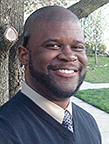 The featured presentation for this strand will be “Scientific Literacy and the Survival of Our Species,” on Thursday, November 12, at 2:00 PM at the Pennsylvania Convention Center, Ballroom B. Presenter Damon Bradley (NASA Goddard Space Flight Center: Greenbelt, MD) will share his own experiences growing up in the dangerous neighborhoods of South Philadelphia, and how, through learning discipline and hard work from his family, he became a research engineer at NASA. From these experiences, he will present some ideas for keeping students and adults engaged and helping to raise the overall scientific consciousness of American society…and why this is imperative for our own survival.
The featured presentation for this strand will be “Scientific Literacy and the Survival of Our Species,” on Thursday, November 12, at 2:00 PM at the Pennsylvania Convention Center, Ballroom B. Presenter Damon Bradley (NASA Goddard Space Flight Center: Greenbelt, MD) will share his own experiences growing up in the dangerous neighborhoods of South Philadelphia, and how, through learning discipline and hard work from his family, he became a research engineer at NASA. From these experiences, he will present some ideas for keeping students and adults engaged and helping to raise the overall scientific consciousness of American society…and why this is imperative for our own survival.
Below is a small sampling of other sessions on this topic:
- En-gene-eering: An Engineering Design Challenge for Genetics
- Your Own Space Program: Engineering a Complete Rocket Launch/Flight/Analysis System from First Principles to Apogee
- Building Green: Designing Sustainable Solutions
- Understanding Car Crashes: Engineering Truly Impactful STEM Lessons
- Nanotechnology in the K–12 Classroom
- Whoa! Is It Windy!? Engineering a Wind Detection Device
 Want more? Browse the program preview, or check out more sessions and other events with the Philadelpia Session Browser/Personal Scheduler. Follow all our conference tweets using #NSTA15, and if you tweet, please feel free to tag us @NSTA so we see it!
Want more? Browse the program preview, or check out more sessions and other events with the Philadelpia Session Browser/Personal Scheduler. Follow all our conference tweets using #NSTA15, and if you tweet, please feel free to tag us @NSTA so we see it!
The mission of NSTA is to promote excellence and innovation in science teaching and learning for all.
Future NSTA Conferences
2015 Area Conferences
2016 National Conference
2016 STEM Forum & Expo
Follow NSTA
3 Key Ingredients for Successful STEM Implementation: Trust, Collaboration, and Innovative Thinking
By Guest Blogger
Posted on 2015-10-04
A recent Education Week blog post entitled “STEM Reforms in Needy Schools Eroded Quickly” painted a disappointing picture of STEM education reform. In this post, part 2 of a 2-part series* from the National Science Teachers Association (NSTA), Adaliz Gonzalez (the Citywide Instructional Lead for Middle School Science in the Department of STEM at the New York City Department of Education) responds.
Common definitions of STEM focus on the seamless integration of science, technology, engineering, and mathematics. Such integration works well when teachers, who are the experts and responsible parties of delivery of instruction in schools, have initial training, time to plan collaboratively, and (most important) common belief about how students learn best. The National Research Council has stated (and it is well known) that state assessments are not aligned to any STEM program, nor do they assess students’ performance in the progression of knowledge as STEM programs deliver instruction. Therefore, schools districts or schools interested in developing and incorporating STEM programs should think about (1) ways to integrate formative and summative assessments that evaluate student performance around content knowledge and skills necessary in STEM education, and (2) the development of performance tasks that can be used as interim assessments aligned to STEM education and that can inform teachers and school leaders about students’ readiness for state assessments.
Ask the Right Questions, Right from the Beginning
Districts such as Buffalo and Denver implemented STEM programs in struggling schools as a way to remediate and/or motivate students. However, the question for these districts should be: What needs assessments were conducted that informed plans about the deficiencies of students and pedagogy and that would inform sudden reforms that included implementing STEM programs? What steps were taken to help develop a shared vision and to understand teachers’ beliefs about how these students learn best (as well as the common interest combined with aspirations prior to implementing STEM programs in struggling schools)? Part of the failure of STEM programs could be the result of jumping onto the STEM bandwagon too quickly and pushing programs without proper training and transition and without taking into consideration the complexity of what STEM in schools encompasses.
The report states that programs “were cut or watered down, due in part to challenges balancing graduation requirements and STEM courses, accountability measures, and students’ preparedness.” The conclusion is that no one can measure the effectiveness of a program that is implemented one year and then changed over the next few years to meet different requirements. Second, state accountability measures, students’ preparedness, scheduling and teacher programs, and graduation requirements are part of a thoughtful planning process that must happen prior to implementation.
For effective implementation of STEM programs, school leaders need to ensure that there is a gradual change in the school culture, creating one that nurtures trust, collaboration, and innovative thinking. Second, schools in which most of the population receives free or reduced lunch depend greatly on federal and state funds as well as grants that can enhance what is offered to students to enrich their academic repertoire and provide them with a different perspective on how they can use their knowledge and expand their perspective of the career world. However, one common mistake made by schools is to allow their vision to be shaped by these programs and grants, which commonly run out and end after a period of time. Prior to implementing any program or applying for grants, schools teams need to ask: How will this initiative enhance our current curricular offerings? How can this STEM program be a sustainable practice?
Creating STEM programs in schools must do four basic things:
- Create a shared vision and culture of trust, collaboration, and innovative thinking.
- Develop curriculum guides and instructional programs that include integration of content, development of skills across subjects, and extracurricular activities aligned to students’ interest and instructional offerings.
- Have a plan to align the use of resources, human capital, outside organizations, school and outside funds toward achieving the vision for STEM education, as well as aligning key partnerships that will contribute to a sustainable culture and the following of best practices in STEM education.
- Provide all students with opportunities and awareness of requirements to be highly motivated and pursue STEM careers and college paths.
Successful STEM reform addresses these issues from the start. I will be presenting examples of schools that implemented STEM programs, creating sustainable practices that promoted successful implementation of STEM education, on November 7 in the NSTA Virtual Conference Shifting to Integrated STEM: Experiences of Three School Districts. My co-presenters and I will give several examples in which systemic changes have brought about significant improvements in STEM teaching and learning. We will also discuss what it takes to implement such changes, including the absolute requirement of support by top leaders. Learn more and register. Register early by Friday, October 9, and save $10 off your registration fee: Use promo code NOV_SAVE10.
 Adaliz Gonzalez is the Citywide Instructional Lead for Middle School Science in the Department of STEM at the New York City Department of Education. She served as a science and math teacher for eighth grade bilingual students in Inwood Intermediate School in New York City for over ten years, and as a Peer Instructional Coach, mentoring colleagues in the understanding using the new teacher reflection rubric.
Adaliz Gonzalez is the Citywide Instructional Lead for Middle School Science in the Department of STEM at the New York City Department of Education. She served as a science and math teacher for eighth grade bilingual students in Inwood Intermediate School in New York City for over ten years, and as a Peer Instructional Coach, mentoring colleagues in the understanding using the new teacher reflection rubric.
*Read Part 1: Successful STEM Reform: Leadership Is Key
The mission of NSTA is to promote excellence and innovation in science teaching and learning for all.
Follow NSTA
#NSTA Social Scene: October 3, 2015
By Lauren Jonas, NSTA Assistant Executive Director
Posted on 2015-10-03
What are science teachers doing in social media this week? Here’s our top 10 favorites!
#1 SHARKTOBER
Is there a better time of year than #Sharktober? We don’t think so! #EarthIsBlue (Photo: @sharkstewards) pic.twitter.com/a2iIsQUF43
— Sanctuaries (NOAA) (@sanctuaries) October 3, 2015
#2 Science Teachers Rock!
Keynote @ainissaramirez reminding science teachers that their power is to rock people’s world #cascience15 #NGSS pic.twitter.com/CjWPzLhLWK
— Jill Grace (@flabellinaJG) October 2, 2015
#3 Must Read
#Teaching Manhattan Project #chemistry #civics in latest issue of Science Teacher @TST_NSTA @NSTA #cdnedchat #edchat pic.twitter.com/CVI1zzIKAK
— Niels Walkau (@walkau) October 3, 2015
#4 Save The Date
Q & A for HS Students and Scientists/Astronauts about #YearInSpace -Thrs Oct 8th 9 pm EDT on #scistuchat – http://t.co/KefasTPIQV
— Adam Taylor (@2footgiraffe) October 4, 2015
#5 Astronaut Alert
Hangin w/ Barbara Morgan as @NSTA plans next gen @Exxonmobil Phil Mickelson Teachers Academy http://t.co/GOC7nM580n pic.twitter.com/1hn5c7jeZu
— Al Byers (@alsbyers) October 1, 2015
#6 Rethink STEM Reform
How do you achieve successful #STEM reform? Cary Sneider weighs in on the #NSTA blog! http://t.co/xMvYgnrhxl pic.twitter.com/3X0P2hr3UX
— NatSciTeachAssoc (@NSTA) October 2, 2015
#7 Mars Onscreen
Science Goes To The Movies: Hear @astro_Pettit and @tweetsoutloud review @MartianMovie http://t.co/O7T3VFF2Pz pic.twitter.com/oIeGhuxwi3
— Science Friday (@scifri) October 3, 2015
#8 Candies Not Optional
Bring: Chewy & cube caramels, jelly candy, American & European gummy bears, candy corns! http://t.co/El4LfjCql3 pic.twitter.com/1I8Uuq67JA
— ACS Webinars (@acswebinars) October 2, 2015
#9 Eye in the Sky
.@Universetoday Borderline Cat 5 Hurricane Joaquin Spied from International Space Station: C… http://t.co/P8ReMDBuNT #astronomy #space
— BlackPhysicists (@BlackPhysicists) October 3, 2015
#10 ICYMI
#NGSSchat #wiki is updated! Check it out here: http://t.co/eJSz2gUHN1. Thanks to @2footgiraffe for the #Storify!
— Fred Ende (@FredEnde) October 3, 2015
Meeting the Demand for Future STEM Teachers
By Debra Shapiro
Posted on 2015-10-02

Third graders in Hofstra University’s STEM Studio ponder how to display the data generated from their pre-exercise/post-exercise pulse rate experiment. Photo courtesy of HOFSTRA UNIVERSITY
The University of Virginia (U.Va.) made headlines in August when it announced its new five-year, undergraduate dual-degree program that will allow students to earn a bachelor’s degree in engineering and a master’s degree in teaching, along with a license and endorsement in chemistry, physics, or math. U.Va. joins other universities around the country in offering these programs to meet the demand for science, technology, engineering, and math (STEM) teachers.
“The impetus [for U.Va’s new program] is the Next Generation Science Standards (NGSS),” says Jennifer Chiu, assistant professor in the university’s Curry School of Education. The new standards “place a lot of emphasis on engineering, but most science teachers have a background in science, not engineering. [The dual degree provides] an opportunity to encourage those with an engineering background to become science teachers and to incorporate engineering into science classrooms,” she explains.
The dual degree also was created “out of student interest,” says Chiu. Advisors have reported that engineering students have expressed interest in teaching, with many “suggesting a possible career pathway [of using] their engineering degree for the benefit of society,” she relates.
Students who complete the program “come out with an engineering bachelor’s degree and can work in industry, and are certified to teach in multiple content areas in Virginia.” They earn endorsements in physics, chemistry, and math because engineering degrees require a lot of basic foundation courses in those subjects; “biology and Earth science endorsements involve courses not as prevalent in the engineering major,” she explains.
U.Va. is offering scholarships to students who apply for the program. Ten $10,000 scholarships were awarded this semester, and “five or six” that will “fully fund the students for the master’s portion” are expected to be awarded next year, according to Chiu. “We’re trying hard to get people through [the program],” she adds.
The university also offers experiences to support students in becoming practicing teachers. “Field placements provide opportunities to teach peers science and engineering in methods courses, and weekly student teacher seminars present strategies and solutions to engage students in ways that reflect the practices of the NGSS,” she notes.
Recruiting Engineering Students
Last winter, Philadelphia’s Drexel University launched DragonsTeach, a new program that gives STEM majors the opportunity to minor in STEM education and obtain secondary teaching certification along with their STEM degree. DragonsTeach is a collaborative effort of the College of Arts and Sciences, the College of Engineering, and the School of Education, and is supported by a $1.45 million grant from the National Math and Science Initiative. Eligible students include chemistry, biology, physics, mathematics, and engineering majors.
DragonsTeach arose, in part, from Drexel’s desire to improve the quality of STEM education in the Philadelphia region, as well as its commitment to become the most civicly engaged university in the country. “As a result of the university-wide emphasis on community and education,” says Jason Silverman, DragonsTeach co-director, “a lot of our STEM students are interested in K–12 work, and through DragonsTeach, these students are able to provide meaningful STEM lessons and experiences to Philadelphia students while learning about a career in education.”
DragonsTeach is a partner of the nationally acclaimed UTeach program established by the University of Texas at Austin. “DragonsTeach is unique because it offers an opportunity to recruit engineering students into teaching,” says Jessica Ward, DragonsTeach director of operations. “Historically, UTeach has had difficulty recruiting engineers,” she reports.
Additionally, because Drexel is a five-year, co-op institution, “[t]his means that while students are completing their undergraduate degrees, they can also complete up to 18 months of work experience,” she explains, “so we are recruiting students who are already career-oriented.”
As an incentive beyond additional career options, DragonsTeach provides a stipend to students who earn a B or better in the two introductory recruitment courses: Inquiry Approaches to Teaching and Inquiry-Based Lesson Design. In these courses, DragonsTeach students teach lessons in elementary and middle schools, and “the younger students’ energy and interest in the STEM activities ultimately excite our DragonsTeach students about teaching,” Ward says.
The first two courses help students “know sooner rather than later if teaching is right for [them],” she notes. And after taking them, “even if you don’t want to teach, a lot of the skills learned are applicable to any career,” she contends.
For example, if a student opts for graduate school, he or she will find “the 5E model is good for a teaching assistant job in any major,” she points out. DragonsTeach courses foster communication and leadership skills; co-teaching prepares students “to work in a team environment”; and designing lessons increases creativity and shows students “how to get someone interested in the material you’re trying to convey,” she asserts.
DragonsTeach students teach high school students in subsequent courses, such as Knowing and Learning in Science and Mathematics, in which “students begin to delve into the NGSS,” Ward relates.
Focusing on Engineering Design
Twenty years ago, Dave Burghardt, engineering professor at Hofstra University in Hempstead, New York, co-created a STEM master’s degree program with “children’s engineering and engineering design at its heart,” he explains. Elementary teachers in the program develop the “knowledge, skills, and attitudes essential for using informed engineering design as a pedagogical strategy in K–12 STEM education,” according to the program’s description. The goal is “design-based activity,” says Burghardt.
With that degree program in mind, Burghardt decided to create “an accessible bachelor’s degree in STEM as a co-major for elementary education majors.” The degree would not require a lot of math courses; it just required “basic algebra, logic, and [an] understanding of math systems, along with introductory, non-major courses in chemistry, biology, and astronomy, and lots of hands-on learning,” he asserts, noting that most bachelor’s degree programs for elementary education majors only require one math and one science course. The degree would feature two STEM capstone courses to provide a broad understanding of the scientific and mathematical foundations of the natural and human-made worlds.
Best of all, every course except the two capstone courses already were being taught at Hofstra. “It was an effective way to use existing resources and can be replicated easily at other schools,” he maintains. “The capstone courses make it unique.”
Burghard
t’s creation, the “BA in STEM, always has engineering design at heart because it enhances a lot of kids’ creativity,” he contends. The degree features “children’s engineering as a part of elementary educators’ portfolio to make science and math more interesting in the classroom. And it does—we have research supporting that,” he declares.
Students earning the degree “have a broad background in all subjects, but also a strong STEM background,” he explains. He tells students, “It’s very accessible, and you’ll be able to enjoy [teaching the material] and impart that to your students. Kids sense when their teacher likes the subject matter…Even [if] you haven’t been a science star in high school, you can be a good STEM teacher.”
The degree makes students more marketable because “superintendents are looking for people with this background,” he reports, noting that the degree “is totally consistent with the NGSS because of its focus on engineering design. It makes it easier to teach to the NGSS.”
This article originally appeared in the October 2015 issue of NSTA Reports, the member newspaper of the National Science Teachers Association. Each month, NSTA members receive NSTA Reports featuring news on science education, the association, and more. Not a member? Learn how NSTA can help you become the best science teacher you can be.
The mission of NSTA is to promote excellence and innovation in science teaching and learning for all.
Follow NSTA
Do You Know What You Do Not Know?
By Christine Royce
Posted on 2015-10-01
The recent report by the Pew Research Center was titled “A Look at What the Public Knows and Does Not Know About Science” and according to their website found “….. that most Americans can answer basic questions about several scientific terms and concepts, such as the layers of the Earth and the elements needed to make nuclear energy. But other science-related terms and applications, such as what property of a sound wave determines loudness and the effect of higher altitudes on cooking time, are not as well understood.
There is no doubt that American’s or at least American students have been compared to international counterparts on a variety of different assessments throughout the ages. However, this particular study is a bit different in that it takes twelve questions – one per science topic and utilizes it to measure the public’s knowledge about science in general.
As noted in this month’s edition of the Leaders Letter, popular news media outlets picked up this story as well and Live Science summarized the findings in a short and to the point story. A counter point to this study appeared in Science News where it states that the study was “heavy on trivia and light on concepts” and is worth reading for a balanced view on this now trending on social media report on American’s understanding of science.
So, a better question is, do you know what you do not know? Or better yet…. do you know what your students do not know or have misconceptions about?
There are a variety of resources that help teachers tackle common (or not so common) misconceptions in science and some of these include:
- Understanding Science and How It Really Works
- Common Elementary Student Misconceptions in Science
- Uncovering Student Ideas Series from NSTA Press
- Picturing to Learn
Some groups even help you develop your own assessment to test student’s misconceptions:
As an educator or those who work with professional development opportunities, it may be worthwhile to actually test your own conceptual knowledge or build that into an actual PD event utilizing the professional development indexer which is part of the NSTA Learning Center. The Professional Development Indexer helps you diagnose your needs in specific science content areas and provide suggestions of NSTA e-PD resources and opportunities you may want to consider as you plan your professional development (PD). The Indexer does not assign a grade or present a score to the questions you answer, but saves a list of recommended resources for later review.
So how do you address what you don’t know or work to address what student misconceptions are?
The recent report by the Pew Research Center was titled “A Look at What the Public Knows and Does Not Know About Science” and according to their website found “….. that most Americans can answer basic questions about several scientific terms and concepts, such as the layers of the Earth and the elements needed to make nuclear energy.
Documenting weather changes
By Peggy Ashbrook
Posted on 2015-10-01
 As the wind stirs up and we get a full day of long-awaited rain, children arrive at school in rain boots and coats, and a few in soaking wet sandals. Hurricane Joaquin will bring more rain and wind this weekend as it moves north in the Atlantic, hopefully off the coast not inland.
As the wind stirs up and we get a full day of long-awaited rain, children arrive at school in rain boots and coats, and a few in soaking wet sandals. Hurricane Joaquin will bring more rain and wind this weekend as it moves north in the Atlantic, hopefully off the coast not inland.
Taking young children outside to observe the short-term conditions of the atmosphere—weather—is a foundation for later learning about the average daily weather for an extended period of time at that location—climate—as defined by the National Ocean Service of the National Oceanic and Atmospheric Administration.
Visit the National Weather Service’s JetStream: Online School for Weather page and scroll down to see the Köppen climates map. The continental USA has ranges in normal temperatures and amounts of precipitation, so no single lesson plan on weather observations 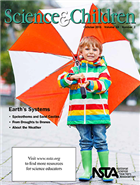 will be a good fit for all. Teaching about your local weather will provide the most opportunities for direct observation that can deepen children’s understanding about weather.
will be a good fit for all. Teaching about your local weather will provide the most opportunities for direct observation that can deepen children’s understanding about weather.
In the October 2015 issue of Science and Children I wrote about children counting and graphing the number of short sleeve shirts, sweaters and jackets that classmates wore to school each day. The clothing is a symbol for the weather, and observing changing trends in outerwear is a focused way to track changes in the immense phenomena that is weather.
NSTA’s K-12 October 2015 Science Education Journals Online
By Korei Martin
Posted on 2015-10-01
Looking for ways to talk about climate change with your students? Are your students curious about the nature of science? Want to know how to create interdisciplinary lessons connected to real-world applications? The October K–12 journals from the National Science Teachers Association (NSTA) have the answers you need. Written by science teachers for science teachers, these peer-reviewed journals are targeted to your teaching level and are packed with lesson plans, expert advice, and ideas for using whatever time/space you have available. Browse the October issues; they are online (see below), in members’ mailboxes, and ready to inspire teachers!
Science and Children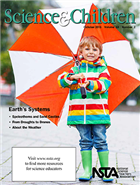
Our rapidly changing climate increases the need for even our youngest students to have a strong background in this area of science. This issue of S&C will help you teach your students about Earth’s systems, with a particular focus on climate.
Featured articles (please note, only those marked “free” are available to nonmembers without a fee):
- Free – Speleothems and Sand Castles
- From Droughts to Drones
- Animal Detectives
- NGSS in Action
- Free – Editor’s Note: Earth’s Systems: Climate
- Free – DCIs, SEPs, and CCs, Oh My!
- Teaching Through Trade Books: Wonderful Water
- Full Table Contents
Science Scope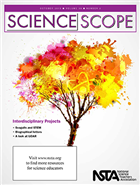
Although middle level science classes often seem self-contained to students, scientific disciplines—and the scientific field at large—do not exist in isolation. The articles in this issue of Science Scope will show you how to collaborate with other science and content-area teachers to create interdisciplinary lessons connected to real-world applications.
- Free – See Less Sea-Less Seagulls: Planning for an Interdisciplinary STEM Unit
- Shrimp and Black Gill: Studying the Effect of Apostome Ciliates
- Free – DCIs, SEPs, and CCs, Oh My! Understanding the Three Dimensions of the NGSS
- Connecting the Dots: Lasers Link Students to Their 3-D World
- Using Biographical Letters to Draw on the Nature of Science
- Using a STEM-Based Approach to Make Recycling Metallic Elements Relevant
- Free – Editor’s Roundtable: Interdisciplinary Teaching
- Full Table of Contents
The Science Teacher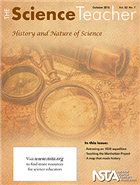
Learning about the nature of science (NOS) is certainly as important as learning about scientific laws and theories. In this increasingly scientific and technological age, personal and societal decisions require a clear understanding of scientific knowledge and how it is generated. NOS tenets need to be intentionally targeted in classroom activities and laboratory investigations and incorporated into all our science teaching. Using case studies from the history of science can help develop students’ understanding of the nature of science and the diverse individuals practicing science and engineering today, as articles featured in this issue illustrate.
Featured articles (please note, only those marked “free” are available to nonmembers without a fee):
- Free – Teaching the Manhattan Project
- William Smith’s Mapping Milestone
- Chemical Solitaire
- A Cool Controversy
- Are We Alone in the Universe?
- Free – DCIs, SEPs, and CCs, Oh My! Understanding the Three Dimensions of the NGSS
- Free – Editor’s Corner: The Nature of Science
- Full Table of Contents
Get these journals in your mailbox as well as your inbox—become an NSTA member!
The mission of NSTA is to promote excellence and innovation in science teaching and learning for all.
Follow NSTA
Build Your Professional Network
By sstuckey
Posted on 2015-10-01
In this video, columnist Ben Smith shares information from the Science 2.0 column, “Build Your Professional Network,” that appeared in a recent issue of The Science Teacher. Read the article here: Build Your Professional Network
[youtube]https://www.youtube.com/watch?v=bxgIKB6WIuM&list=PL2pHc_BEFW2LU1a1jgiLNu4NABGw1Zx-Y&index=66[/youtube]
In this video, columnist Ben Smith shares information from the Science 2.0 column, “Build Your Professional Network,” that appeared in a recent issue of The Science Teacher. Read the article here: Build Your Professional Network
[youtube]https://www.youtube.com/watch?v=bxgIKB6WIuM&list=PL2pHc_BEFW2LU1a1jgiLNu4NABGw1Zx-Y&index=66[/youtube]




